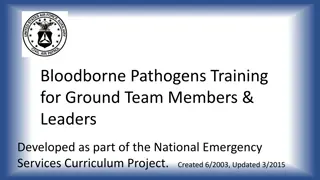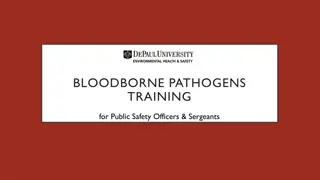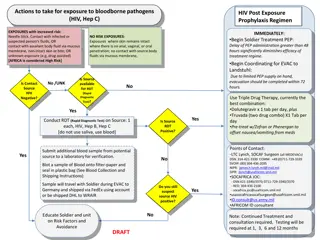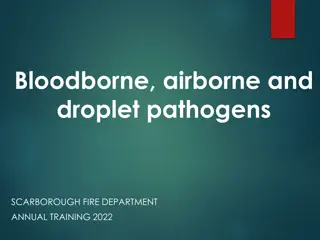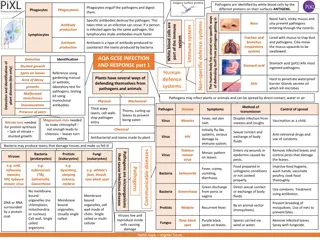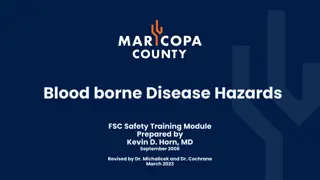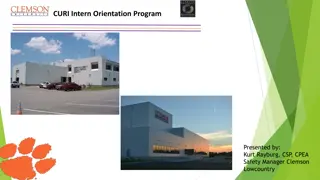Bloodborne Pathogens Training Overview
This presentation provides essential information on Bloodborne Pathogens Training, emphasizing the importance of understanding and managing exposure to potentially infectious materials. It covers topics such as the Bloodborne Pathogens Standard, Exposure Control Plan, hazards associated with BBPs, and how these pathogens spread. The training highlights the significance of safe work practices and the rights of employees in case of exposure incidents.
Download Presentation

Please find below an Image/Link to download the presentation.
The content on the website is provided AS IS for your information and personal use only. It may not be sold, licensed, or shared on other websites without obtaining consent from the author. Download presentation by click this link. If you encounter any issues during the download, it is possible that the publisher has removed the file from their server.
E N D
Presentation Transcript
Bloodborne Pathogens Training
Please view this presentation as a slide show in order for the links to be active. Navigate to the slide show tab at the top, then select From current slide.
s Bloodborne Pathogens Standard Designed to protect employees with occupational exposure to blood or other potentially infectious materials (OPIM) For our purposes, all bodily fluids should be considered OPIM Requires DePaul to have an Exposure Control Plan Click here to view the BBP standard
Current version is maintained on EHS website Identifies positions and tasks that involve exposure to blood/OPIM DePaul s Exposure Control Plan Describes safe work practices and procedures Outlines employees rights to receive the hepatitis B vaccination as well as confidential medical evaluation and follow up in case of exposure Several departments maintain their own ECP specific to their operations A template is provided for this purpose in Appendix A 4
Even if you are not usually exposed to blood/OPIM, it is important to be aware of the hazards and know how to react if you find yourself in such a situation. !
What are BBPs? Microorganisms present in human blood that can cause disease in humans. Examples: Can be bacteria, viruses, protozoa, fungi Human Immunodeficiency Virus (HIV)/Acquired Immune Deficiency Syndrome (AIDS), Hepatitis B Virus (HBV) & Hepatitis C Virus (HCV) are of most concern in the US More on these later
How do BBPs spread? BBPs are not spread by casual contact (shaking hands, hugging, using a toilet, drinking from the same glass, sneezing, coughing). Infected blood must enter another person s bloodstream in order for infection to occur. This can happen via: Puncture with needles or other sharp objects A break in the skin, including rashes or abrasions Mucous membranes (eyes, nose, mouth, etc.)
Administering first aid or CPR Cleaning up blood/bodily fluids after an injury How could you be exposed at work? Emptying trash containing wrongly placed contaminated or sharp items Handling sharp objects or biohazardous waste Laundering gym clothes, towels, etc. Touching a contaminated surface Using an improperly cleaned/disinfected tool Working with clients who may be combative Working with BBPs in a laboratory
Anyones blood or bodily fluids might carry BBPs. A person you know well A person who does not appear to be ill A person of any gender, age, race, sexual orientation or any other characteristic
There are currently ~36.7 million people worldwide living with HIV/AIDS The only way to know if you have HIV is to get tested HIV carriers can live nearly as long as those without it, if they are treated before it progresses HIV attacks T-cells, a vital component of the immune system HIV/ AIDS There are 3 stages of HIV: 1. Acute infection: Some develop a flu-like illness, others do not show any symptoms. 2. Clinical latency: Some may still experience no symptoms. Can last a decade or more. 3. AIDS: If untreated, people with AIDS typically only live ~3 years. Does not survive for long on surfaces HIV 101 sheet More information
Testing is required to determine HBV/HCV status HBV can survive on surfaces for up to 1 week HCV, for 3 weeks An important difference between HBV & HCV is that there is a safe and effective vaccine for HBV. Learn more on the next slide! Can last a few weeks (acute) or a lifetime (chronic) Up to 2.2 million and 3.9 million people in the US are currently living with chronic HBV and HCV, respectively Primarily attacks the liver HBV & HCV Symptoms (if present) include fever, fatigue, loss of appetite, nausea, vomiting, abdominal pain, dark urine, gray stools, joint pain & jaundice, and can take decades to develop HBV info sheet HCV info sheet More information
Hepatitis B Vaccine Information Statement Why get vaccinated? Basic info about the vaccine (series of 3-4 shots) Who should not get the vaccine Risks of an adverse reaction The National Vaccine Injury Compensation Program HBV Vaccination & Medical Evaluation IFYOUDECLINEVACCINATION: You can elect to receive it any time during your employment that you still have occupational exposure. IFYOUHAVEANEXPOSUREINCIDENT: You are entitled to confidential medical evaluation and any necessary follow up, in accordance with the BBP standard. The vaccine, medical evaluation and follow up are provided at no cost to employees.
How can we prevent exposure to BBPs?
Universal Precautions An approach to infection control where all blood and bodily fluids are treated as if they contain BBPs. This means: Using the same procedures and level of caution around all blood and bodily fluids, even if you do not suspect they contain BBPs.
Wash Hands After removing gloves properly As soon as possible after using antibacterial or antiseptic wipes these do not replace handwashing Proper handwashing is the single most effective way to prevent the spread of infection.
Handle Sharps Safely Never use your hands to pick up sharp objects. Use tongs, forceps or a hand broom. Do not dispose of uncontaminated sharp objects (e.g. clean broken glass) loosely in the trash where they can injure workers. Place in broken glass container (if you have access to one) or create your own.
Waste Disposal All materials that may be contaminated with blood or OPIM (includes all needles) must be disposed of in a rigid container with the biohazard symbol and warning. EHS can provide you with a 43 gallon bio bin (on the right) if needed. All other containers must be ordered by individual departments.
If the situation is an emergency, CALL 911, then Public Safety. Spill Response Use Use goggles to protect from splashing. disposable, non-latex gloves, such as nitrile. All spills must be cleaned and disinfected promptly, using universal precautions. Block access to the area. Gather supplies and put on PPE. Use a tool to pick up sharp objects. Place in biohazard container. Use absorbent towels or solidifying powder to clean up the spill. Place in biohazard container along with gloves used for this step. Put on new gloves. Spray a 10% bleach solution (must be made fresh) on the spill area, let it stand for 10 minutes, then dry with absorbent towels. Place all materials and PPE used for clean up in a biohazard container. Wash your hands! 1. 2. 3. 4. 5. 6. 7.
If an exposure incident occurs Blood/OPIM makes contact via needlestick or other sharps injury, broken skin or mucuous membranes (eyes, nose, mouth). IMMEDIATELY: Flush exposed area with large amounts of water. Use soap if the exposure occurred on skin (do not put soap in your eyes, nose or mouth). DURINGOR AFTER FLUSHING: Inform your supervisor, instructor or other person in charge. If you require medical evaluation, contact Public Safety. They will transport you to Advocate Illinois Masonic Medical Center. Follow your department s protocol for documenting the incident. (Note: The incident must be recorded on the Sharps Injury Log whenever a sharp object is involved).
Have questions? Contact EHS at any time! (773) 325-3344 ehsoffice@depaul.edu ehs.depaul.edu



